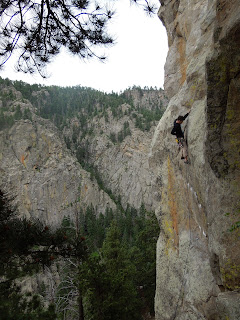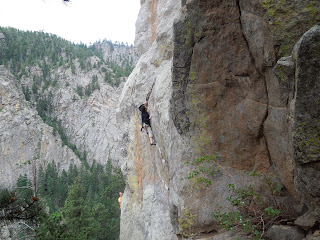So you’ve leafed through your guidebook, found your crag for
the day’s take, and decided on what routes you’re going to work. So how do you
get there? The hike to the cliff base, known as the approach, is the bane of
climbers everywhere. Often unmarked, poorly described and dangerous,
approaching a crag can be as much if not more work than the actual climbing.
Cliffs usually rim the top of a canyon, hang over rivers or rise out of the
earth miles from any accessible road. So you’re going to have to hike to the
top of that canyon, cross that river, or lace up and walk those miles to get to
your destination. Don’t forget you’ve got a heavy pack on - ropes, gear,
harnesses, shoes, food, and water can add up to around 40 pounds per person on
a two-man climbing team.
The approach is such an undertaking that climbing shoe
companies make approach-specific shoes. I used to question the validity of
spending 120 dollars on a pair of hiking boots that are targeted for walking to
a cliff, but after struggling numerous times in tennis shoes, sandals and rock
shoes, I coughed up the cash for a pair. And boy, does it make the difference.
Eric and I both have approach shoes, and they’ve saved our asses many times.
Sharing the same rubber of climbing shoes, approach shoes stick to steep rock
on fourth-class hiking (scrambling up big boulders with the possibility of a
bad fall), hold on wet rock, and offer some ankle support. Just last evening, as we hiked down the mountainside of Sinks
Canyon in Wyoming, a slow-moving climber in front of us had on some slip-on
loafers, and fell at least three times on the way out. Justification complete.
Approaches can be frustratingly difficult to find and
follow. Climber trails are often unmarked, undeveloped, or completely
non-existent. Guidebooks often have vague descriptions that make you question
where the hell you are going. In Boulder Canyon, approaches usually cross a
creek on a cable traverse, then begin on talus - huge boulder fields on the
side of steep mountainsides where no trail exists. You have to pick your way
carefully up the talus, looking for trails to appear, and often end up
following what appears to be a trail into nothing. In Clear Creek Canyon, at
the River Wall, some walls are accessed by wading along the side of the rushing
white water, or accessed by climbing up boulders and over a road tunnel a few
hundred feet above creek. Good foot placement is absolutely crucial.
Here is an excerpt from the Lander Rock Climbs guidebook (written
by Steve Bechtel from Elemental Climbing publishers) that we followed
yesterday:
“Park at the Popo Agie Campground, hike across the swinging
bridge, on the far side, the trail splits. Go straight ahead up some short
steps on a trail heading toward the cliffs on the hill above. After about 3-4 minutes on this trail, it forks. Go right, [then
go left] and head right again. Follow the trail till you hit a fence. Turn left
and follow faint game trails up into the woods. Eventually, these trails
solidify into a trail heading up the drainage gully. As the angle steepens and
the gully narrows, a faint trail breaks left, go to the right of the gully.
About two minutes uphill, a new trail breaks left along the base of this crag.
The routes are a five minute’s walk away.”
We got lost several times. We hiked up steep hills with no
trail looking for trails. We somehow ended up on a trail on top of the cliffs
we wanted to climb. By the time we got to the crag, sweaty, tired and thirsty,
it was time to go vertical. Just another day in the office.































































